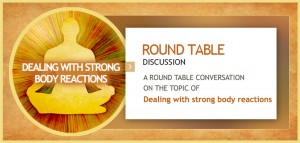August, 2011
Back to Top
TOOL TUESDAY: Concurrent and Cascading Fears
It’s Tool Tuesday. Every Tuesday I share one of Eloheim’s tools for spiritual growth.
Today’s Tool is: Concurrent and cascading fears, two different patterns that fears follow in response to triggers.
With cascading fears, the trigger is followed by a train of fears that are similar. A classic example is when somebody cuts you off on the freeway. You react with, “Didn’t he see me?” Then the train of cascading fears starts to form. You might next move to the pain you felt when you were “not seen” and passed over for promotion, then to the suffering you experienced when you were “not seen” and not invited to the prom. Before you are even aware of it, you’re reliving being five years old and upset because someone took your wagon because they didn’t “see you” playing with it.
Cascading fears connect experiences in the present to experiences scattered throughout your history. Not only does this result in you suffering over and over again, but it never allows you to actually attend to what the initial trigger was.
During this cascading fear pattern, you may hear the voice of an authority figure from your childhood narrating the entire sequence. That is a way to alert yourself to the pattern.
You tend to have “favorite” cascading fear patterns that you turn to even if the initial triggers are quite varied. When you catch yourself in this fear pattern, gently remind yourself to come back to the moment, choose to stay in the moment, and allow yourself to become more conscious about your reaction to the initial trigger.
In the case of concurrent fears, the trigger is followed by a train of fears on completely different subjects, each of the fears pertaining to your current experiences rather than going into past experiences.
This pattern is typically used when you are dealing with the top triggers: Money, sex, job, housing, relationships, health. You find yourself triggered by one of these and rather than becoming conscious of the trigger and using it for your growth, you jump to the next subject. You take the triggered state with you and find something to be triggered about with the next subject.
This jumping from subject to subject and trigger to trigger is full of suffering. It makes it very difficult to actually transform any one situation. You never stay with it long enough to change it. Concurrent fears can leave you feeling like your life is full of problems and you are unable to cope with any of them.
As an example of concurrent fears, let’s say you’re worried about your marriage. Thinking about your marriage is too triggering, so you jump to thinking about your job. You think about your job until that is too triggering, then you jump to worrying about your heath, and on it goes. Nothing ever changes. Even the thoughts you have about each of these subjects are unchanging. You simply use the hamster-wheel mind to continue to run in circles. Suffering is the result.
The key is to pick one subject and stick with it long enough to bring consciousness to it. The pattern will try to draw you away from that one subject, but choose and choose again to stick with it, past the discomfort you are feeling.
You are looking for new information, but new information doesn’t come from rehashing old thoughts, it comes from insight. When you apply consciousness to one subject you can actually be in the moment with it long enough to get to the “aha.”
***
Veronica writes:
I think this tool gets the award for the tool with the most awkward name. We never did come up with a more clever way to say it. This one is really helpful in alerting you to patterns of habitual fears. I don’t know how many times I have done that: trigger in the moment and all of a sudden I’m five again thing. Being aware of these patterns really helped me change them.
***
For me, this tool combines well with “What is true now?” tool. When I find myself spinning off into the past or projecting into the future, I can stop myself short if I just remind myself that what is true now has nothing to do with either the past or the future. It’s especially obvious to me when I’m worried about money and just switch over to worrying about my health, with no break in between! I’ll know that these concurrent fears are just my hamster-wheel thinking taking me out of the moment, where my conscious self would actually rather be.
—Claire
If you would like to read more of our Tool Tuesday entries, use these links:
Candle Wax (Nobody Gets Your Wax)
Who Answers the Door?
Velcro – Don’t Have Velcro For That
Preferences / Judgments
Shovel or Ladder
There are more Eloheim and The Council tools in our books:
The Choice for Consciousness, Tools for Conscious Living
The Homo Spiritus Sessions

TOOL TUESDAY: Shovel or Ladder
Today is Tool Tuesday! Shovel or ladder
Every Tuesday I share one of Eloheim and The Council’s tools for spiritual growth.
The choice for consciousness is challenging, but habitual response is a pit of pain.
You get a shovel or a ladder, it’s your choice to dig yourself in deeper or to climb up the ladder and out of the pit. The shovel is repeating habit, it’s you not being willing to say, “What the hell is going on here in me? Not with him, not with her, not with the boss, not with the kids, not with the bank, not with the credit card statement but within me. What is going on in me?”
“Am I going to dig myself in deeper out of fear, guilt, lack, victim hood, or am I going to put my hand on the ladder and say something has to change? And am I going to keep climbing the ladder even when my pit partners look at me and say, ‘What are you doing? Where are you going? Who do you think you are? You’re getting too big for your britches!’” and all those other lines that they might give you. The ladder isn’t just a hop. You’re so far down in these pits of habitual response that you need one of those tall ladders, but the beauty is your ladder is tall enough.
You figure it out by putting one foot in front of the other and continuing to make the choices that say, “Habit is not who I am.” Because when habit gets to tell you who you are, the scenery doesn’t change. Do you want a shovel or a ladder? We will not give you shovels. But we have loads of ladders of all different sizes, shapes, and lengths and we even know how to make them taller. So if you get dug down in there, don’t think you’re ever lost. You’re not ever lost in the pit of habit. You simply have to keep making the choice.
We’re standing there cheering you on. Just lift your foot. We know it’s challenging to break habits, but it will get easier. If you want your life to change, you need to choose and choose again to climb the ladder of consciousness.
***
Veronica writes:
When Eloheim first came up with this one, I was blown away. It is classic Eloheim, funny and practical. I picture them standing at the top of the hole saying, “We have ladders for you!” There is something so comforting about the image of them standing in the light looking at us down in the dark just waiting for us to reach up for the ladder they are lowering.
***
When dealing with a coworker who flips into hysteria/doom and gloom thinking when confronted with a problem, I find it helpful to use the Shovel (are you really sure you want to dig that great big huge hole for yourself?) / Ladder (don’t you think we might actually get a better overview of this problem from up here?) approach. I used to call this the “Take the noose off your neck and get down from that chair” maneuver. But I like shovel/ladder now because it actually offers an alternative way of thinking about the situation rather than just a plea for different behavior.
—Rene
If you would like to read more of our Tool Tuesday entries, use these links:
Candle Wax (Nobody Gets Your Wax)
Who Answers the Door?
Velcro – Don’t Have Velcro For That
Preferences / Judgments
There are more Eloheim and The Council tools in our books:
The Choice for Consciousness, Tools for Conscious Living
The Homo Spiritus Sessions




 Eloheim and Veronica
Eloheim and Veronica @channelers on Twitter
@channelers on Twitter Youtube Channel
Youtube Channel RSS Feed
RSS Feed E-mail Newsletter
E-mail Newsletter
